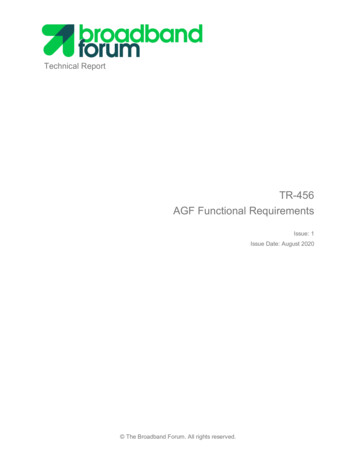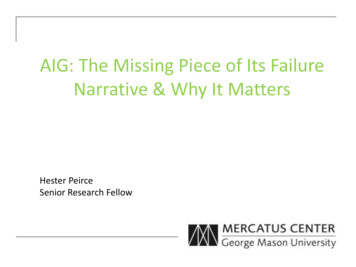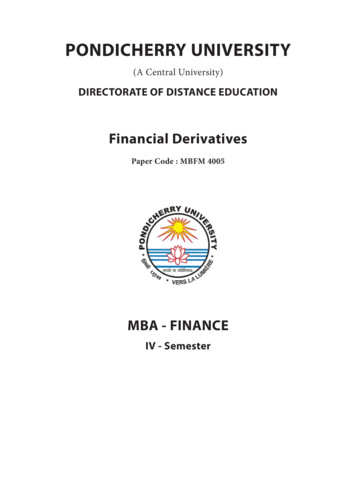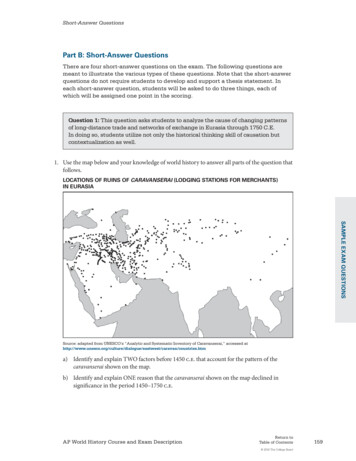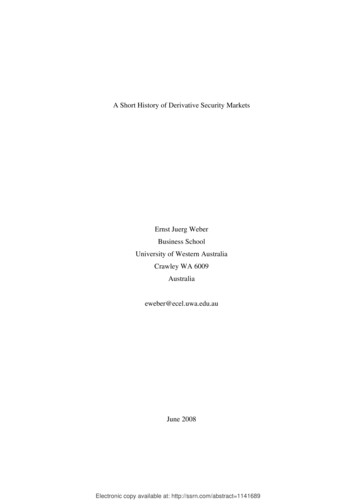
Transcription
A Short History of Derivative Security MarketsErnst Juerg WeberBusiness SchoolUniversity of Western AustraliaCrawley WA 6009Australiaeweber@ecel.uwa.edu.auJune 2008Electronic copy available at: http://ssrn.com/abstract 1141689
AbstractContracts for future delivery of commodities spread from Mesopotamia to Hellenistic Egyptand the Roman world. After the collapse of the Roman Empire, contracts for future deliverycontinued to be used in the Byzantine Empire in the eastern Mediterranean and they survived incanon law in western Europe. It is likely that Sephardic Jews carried derivative trading fromMesopotamia to Spain during Roman times and the first millennium AD, and, after beingexpelled from Spain, to the Low Countries in the sixteenth century. The first derivatives onsecurities were written in the Low Countries in the sixteenth century. Derivative trading onsecurities spread from Amsterdam to England and France at the turn of the seventeenth to theeighteenth century, and from France to Germany in the early nineteenth century. Circumstantialevidence indicates that bankers and banks were at the forefront of derivative trading during theeighteenth and nineteenth centuries.iElectronic copy available at: http://ssrn.com/abstract 1141689
Modern textbooks in financial economics often misrepresent the history of derivativesecurities. For example, in the opening sentence Hull (2006) suggests that derivatives becamesignificant only during the past 25 years, and that it is only now that they are traded onexchanges."In the last 25 years derivatives have become increasingly important in the world of finance.Futures and options are now traded actively on many exchanges throughout the world." (Hull2006, p. 1)Mishkin (2006) is even more adamant that derivatives are new financial instruments thatwere invented in the 1970s. He suggests that an increase in the volatility of financial marketscreated a demand for hedging instruments that were used by financial institutions to manage risk.Does he really believe that financial markets were insufficiently volatile to warrant derivativetrading before the 1970s?"Starting in the 1970s and increasingly in the 1980s and 90s, the world became a riskier placefor the financial institutions described in this part of the book. Swings in interest rates widened,and the bond and stock markets went through some episodes of increased volatility. As a result ofthese developments, managers of financial institutions became more concerned with reducing therisk their institutions faced. Given the greater demand for risk reduction, the process of financialinnovation described in Chapter 9 came to the rescue by producing new financial instruments thathelped financial institution managers manage risk better. These instruments, called derivatives,have payoffs that are linked to previously issued securities and are extremely useful riskreduction tools." (Mishkin, 2006, p. 309)The widespread ignorance concerning the history of derivatives is explained by a dearth ofresearch on the history of derivative trading. Even economic historians are not well informedabout the long history of derivative markets. A review of three leading economic history journals- the Journal of Economic History, the Economic History Review and the European Review ofEconomic History - has yielded not a single article after 1990 with a title that would indicate thatit deals with some aspect of the history of derivative securities. Similarly, the OxfordEncyclopedia of Economic History (2003) gives short shrift to derivative markets; it includes anentry on commodity futures in the United States in the nineteenth century and options are shortly1
mentioned in the entry on the stock market. At the moment, articles on the history of derivativescan be found only in working papers and edited volumes. Goetzmann and Rouwenhorst (2005)includes an article by Gelderblom and Jonker on derivative trading in Amsterdam from 1550 to1650, and two volumes edited by Poitras (2006/2007) contain the so far most comprehensivecollection of articles and sources on derivative markets during the past four hundred years.The history of derivatives has remained unexplored because there are few historical recordsof derivative dealings. Derivatives left no paper trail because they are private agreements thathave been traded in over-the-counter markets for most of their history. Even today, theinternational commodity and financial markets, which have always been a primary focus ofderivative dealings, remain beyond the reach of national statistical offices. Another reason whyhistorical records of derivatives are scant is conceptual. A forward contract has no market valuewhen it is set up, although its notional value may be large. Thus, how should a forward contractbe recorded when it is set up? There is naturally no point in recording a zero value. This problemis even more acute with futures contracts whose market value does not deviate much from zeroduring their entire life. At the end of each day, the value of a futures contract is set back to zeroby crediting or debiting the daily change in value to a margin account. The Triennial CentralBank Survey of the Bank for International Settlements, which was first published in 1989, for thefirst time addressed the conceptual and practical difficulties of recording derivative dealings ininternational over-the-counter markets.Since there are no official statistics on derivatives, economic historians must rely on othersources that provide evidence that derivatives were used, including laws and regulations, courtdecisions, charters and business conditions of exchanges and trading companies, and survivingderivative contracts. Undoubtedly, the long history of derivatives is little known because theexamination of this material is a laborious task that requires special skills. Kindleberger (1996, p.5) remarked that “Historical research of a comparative sort relies on secondary sources, and2
cannot seek for primary material only available in archives.” There are also not many historiansand economists who are experts both in ancient languages and scripts and in financial economics.In this article, whenever possible secondary sources are used that quote primary sources, forexample Ehrenberg (1928) and Swan (2000). A less reliable source that is also used is thetestimony of financial practitioners who lived and worked in the period under consideration,including de la Vega (1688), Coffinière (1824) and Proudhon (1857).In this chapter the pioneering works of Louis Bachelier (1900) and Vincenz Bronzin (1908)are put into the historical context. In the first section a definition for the generic term “derivative”is given, and the origin of contracts for future delivery of goods in Mesopotamia and their use inthe Greek and Roman world are discussed. In the second section it is shown how the use ofderivatives spread from commodity markets to security markets in Italy and the Low Countriesduring the Renaissance. In the third section, which deals with speculation in Amsterdam in theseventeenth century, it is argued that derivative trading was based on reputation in pre-industrialtimes and beyond. Derivative trading in London and Paris in the eighteenth century is discussedin the fourth section, and the spread of derivative trading in continental Europe during thenineteenth century is considered in the fifth section. Around 1870, financial practitionersdeveloped graphical tools to represent derivative contracts. Profit charts made derivativesaccessible to young scientists, including Louis Bachelier and Vincenz Bronzin, who had themathematical knowledge for the rigorous analysis of derivative pricing. In the last section twoissues are considered that show how difficult it is to provide an unbiased account of the history ofderivatives, using available sources. The focus in this chapter is on the mechanics of derivativedealings; no attention is paid to the emergence of the random walk hypothesis of asset prices,which provided the mathematical foundation for Bachelier and Bronzin’s work. The origin of therandom walk hypothesis is discussed in Jovanovic (2006a) and Preda (2006).3
1. The Origins of Derivatives in AntiquityIt is now hard to believe that the generic term “derivative”, which stands for all kinds ofderivative products, has emerged only very recently, in the 1980s. Swan (2000, p. 5) traces itback to the 1982 New York Federal Court case of American Stock Exchange vs. CommodityFutures Trading Commission. A reliable definition of derivatives is crucial for regulators who arein charge of derivative markets, but the rapid development of new derivative products hasrendered definitions quickly obsolete. A derivative should not be defined as a financialinstrument whose value depends (is derived) from the value of some underlying asset becausethere is no such asset in the case of weather derivatives, electricity derivatives and the derivativeswhose value depended on the outcome of papal elections in the sixteenth century (Swan 2000, p.142). Therefore, financial textbooks - for example Hull (2006, p. 1) - now define derivatives asfinancial instruments whose value can depend on “almost any variable”.Yet, also this definition of a derivative is incomplete because it does not recognize the riskthat the counter-party of a derivative contract may default. During the financial crisis in 1987, thestandard models of derivative pricing failed because they did not take account of the default riskthat arose after the near-failure of Long-Term Capital Management. For this reason, Swan (2000,p. 18) defines a derivative contract as a “promise” whose market value depends, first, on thestrength of the promissor’s ability to perform and, second, on the value of the underlying asset orvariable. Similarly, Moser (2000, 1994), who investigates the history of clearing arrangements atthe Chicago Board of Trade, uses a definition of futures contracts that recognizes the nonperformance option of contract holders because “many futures-contract terms are best understoodas efforts to minimize non-performance costs ” Defining a derivative as a promise with adefault option is crucial in historical research because differences in legal institutions andcustoms created wide disparities in non-performance costs across places and time.4
Derivative contracts emerged as soon as humans were able to make credible promises. In acommercial environment, it is essential for a credible promise that it is somehow recorded.Writing was invented in Mesopotamia in the fourth millennium BC. The invention of writingsatisfied the administrative and commercial needs of the first urban society in human history. Thefirst derivative contracts were written in cuneiform script on clay tablets, which, luckily forfinancial historians, are extremely durable. These derivatives were contracts for future delivery ofgoods that were often combined with a loan. Van de Mieroop (2005) reproduces a tablet in whicha supplier of wood, whose name was Akshak-shemi, promised to deliver 30 wooden [planks?] toa client, called Damqanum, at a future date. The contract was written in the nineteenth centuryBC.“Thirty wooden [planks?], ten of 3.5 meters each, twenty of 4 meters each, in the monthMagrattum Akshak-shemi will give to Damqanum. Before six witnesses (their names are listed).The year that the golden throne of Sin of Warhum was made.” (van de Mieroop 2005, p. 23)Swan (2000, p. 28) displays a tablet from about 1700 BC, in which two farmers receivedfrom the King’s daughter three kurru of barley, which had to be returned at harvest time. Thefarmers, who were brothers, probably used the barely, about 0.9 cubic meters1, as seed stock forplanting a field.“Three kurru of barley, in the seah-measure of Shamash, the mesheque measure, in storage,Anum-pisha and Namran-sharur, the sons of Siniddianam, have received from the naditupriestess Iltani, the King’s daughter. At harvest time they will return the three gur of barley in theseah-measure of Shamash, the mesheque measure, to the storage container from which they tookit. Before (two witnesses whose names are listed). Month Ulul, 19th day, year in which KingAbieshuh completed the statue of Entemena as god.” (Swan 2000, p. 28)This contract may either be viewed as a commodity loan or as a short-selling operation, inwhich the brothers borrowed barley, used it for planting the crop, and then returned it afterharvest. This operation was less innocuous than it looks because the brothers carried some risk. If1In the second millennium BC and earlier, one kurru (kur, gur) was 300 qa, where one qa wasabout one liter (Segrè 1944).5
the crop failed they were required to buy barley in order to be able to return it to the royalgranary. This operation would not have been possible without the sophisticated Mesopotamianirrigation system, which reduced the risk of crop failure due to drought. It is also possible that theKing’s daughter, who represented the state, did not enforce the contract if a widespread cropfailure due to climatic conditions or a locust plague led to famine. In that case the state carried therisk of general crop failure.Derivatives played an important role in the funding of long-distance trade. Zohary and Hopf(2000, pp. 140-141) maintain that the sesame plant was cultivated in the Indus Valley between2250 and 1750 BC. The following tablet, which is from 1809 BC, shows that a Mesopotamianmerchant borrowed silver, promising to repay it with sesame seeds “according to the going rate”after six months. He may have used the silver to finance a trading mission to the Indus Valley toobtain sesame seeds. This contract combines a silver loan with a forward sale of sesame seeds.“Six shekels silver as a šu-lá loan, Abuwaqar, the son of Ibqu-Erra, received fromBalnumamhe. In the sixth month he will repay it with sesame according to the going rate. Beforeseven witnesses (their names are listed). These are the witnesses to the seal. In month eleven ofthe year when king Rim-Sin defeated the armies of Uruk, Isin, Babylon, Rapiqum and Sutium,and Irdanene, king of Uruk.” (van de Mieroop 2005, pp. 21-22)While six shekels of silver was a fair amount of money, it seems not to be enough to financea trading mission from Mesopotamia to the Indus Valley.2 But the merchant probably traded in arange of goods. Therefore, he may have concluded similar contracts for other goods to attractmore funding.It is a tragic fact that slave trade was prevalent during much of commercial history. A tabletfrom 1750 BC provided a slave trader with funding and insurance. At the time when the contract2Around 1800 BC, the price of a slave was about 24 shekels, the wage of a hired worker was onethird of a shekel per month, and it cost one to three shekels to rent a house for a year (Source:Farber 1978). The Eshnunna Code, which was written ca. 2000 BC, stipulated a monthly wage ofone shekel.6
was written, he received 204 2/3 qu of oil in the measure of Shamash. In return, he had to deliverhealthy slaves from Gutium after one month, with an option of paying 1/3 mina 2/3 shekels ofsilver instead of delivering slaves.“204 2/3 qu of oil in the measure of Shamash, to the value of 1/3 mina 2/3 shekels of silver,as the price for healthy slaves from Gutium, Warad-Marduk son of Ibni-Marduk has receivedfrom Utul-Ishtar the troop-commander on the authority of Lu-Ishurra son of Ili-usati. Within onemonth he shall bring healthy slaves from Gutium. If he does not bring them within one month,Lu-Ish(k)urra son of Ili-usati will repay 1/3 mina 2/3 shekels of silver to the bearer of this tablet.Before (four witnesses whose names are listed). Month Ab, sixth day, year in which KingAmmisaduqa, etc.” (Swan 2000, p. 29)This contract provided the slave trader with capital to procure slaves from Gutium. Theoption to pay 1/3 mina 2/3 shekels of silver limited his loss if he was not able to buy slaves at aprice that made the transaction profitable. It also provided insurance against all other hazards ofthe slave trade, including the risk that the slaves fell ill, they ran away, etc. The counterpartyagreed to this transaction if the price of 1/3 mina 2/3 shekels of silver for 204 2/3 qu of oilexceeded the spot price of oil by an amount that was sufficient to adequately compensate forsupplying the initial loan of oil and for the risks inherent in the slave trade. The cuneiform tabletgave the slave trader the option to pay silver to the bearer of the tablet. This suggests that theholder of the tablet could transfer the contract to a third party. But not enough is known onMesopotamian trading practices to determine the significance of the transfer of tablets.About half a million clay tablets have been found so far, with more than 200,000 being heldby the British Museum. The cuneiform digital library initiative (cdli), which is a joint effort of theVorderasiatisches Museum Berlin, the Max Planck Institute for the History of Science and theUniversity of California at Los Angeles, has digitalized about 225,000 tablets, making themavailable on the internet and supplying translations and comments.3 This provides a researchopportunity for economists who are interested in the history of economic institutions. An3The addresses are: http://cdli.mpiwg-berlin.mpg.de and http://cdli.ucla.edu.7
important economic institution that determines economic outcomes is the market itself. Theevolution of markets reflects changing transaction and information costs, which depend ontechnological advances in transport, information processing and administration. The emergenceof contracts for future delivery enhanced the efficiency of agricultural markets in Mesopotamiaand they were a prerequisite for the expansion of long-distance trade.The ascendancy of Greek civilization began around 1000 BC. It is more difficult todocument the use of derivatives for Greek commerce than Mesopotamia. Greek philosophers andhistorians, whose writings profoundly influenced Western civilization, were not interested incommerce. The Greek did not use a medium for commercial contracts that was as durable as claytablets, and laws that have survived as inscriptions on murals and columns were generally hostileto contracts for the future delivery of goods. But it is hard to imagine that farmers were able tofully fund the crop cycle, and merchants had enough capital to finance risky commercialexpeditions, while rich individuals found no way to invest their wealth in commercial endeavorsthat promised a return in the future. The fact that Greek law favored spot transactions does notprove that there were no contracts for future delivery because commercial history is littered withlaws and ordinances against derivatives that were ignored by the public. In fact, the Greek werequite practical in commercial affairs. According to Swan (2000, p. 61), Athens allowed contractsfor future delivery in sea-borne trade because the city depended on the import of grain fromEgypt. Alexander, who invaded the Middle East in the fourth century BC, left the localcommercial and legal system intact, which had descended from Mesopotamia. Therefore, the useof derivatives continued in the Middle East under Greek dominance. Hellenistic Egypt is thesecond period in commercial history from which a large number of commercial contracts hassurvived because papyrus is almost as durable in the desert climate of Egypt as the earlier claytablets.8
The Romans, who copied much of Greek culture, initially adopted the Greek restrictions oncontracts for future delivery. But these restrictions clashed with the commercial realities of thevast Roman Empire, which reached from Britannia to Mesopotamia at its peak. Commoditiesmoved along a network of new roads and the ships of Roman merchants criss-crossed theMediterranean. The city of Rome, whose population grew to one million people, depended ontrade with the provinces, particularly the import of wheat from Northern Africa. During the thirdcentury BC, Roman law caught up with commercial practice, providing for contracts for futuredelivery of goods. Swan (2000, Chapter 3.2) considers the treatment of contracts for futuredelivery in Roman law. Sextus Pomponius, a lawyer who wrote in the second century AD,distinguished between two types of contracts. The first, vendito re speratae, which was void if theseller did not have the goods at the delivery date, provided insurance against crop loss and thehazards of long-distance trade, including the loss of ships in maritime trade. The second, venditospei, was a straightforward forward contract that did not provide for any reprieve to the seller incase he was unable to deliver the goods. It is unclear whether vendito re speratae involved thesame rights as a modern put option because the seller may have been obliged to deliver the goodsif he had them.Early Roman law upheld the principle of privity of contract, which implies that a contractestablishes a relationship that is exclusive to the parties in the contract. A contract was nottransferable because a third party was unable to enforce it. For example, a credit contractestablished an exclusive relationship between lender and borrower. The lender could not assignhis right to repayment of principal and interest to someone else because the borrower was onlyobliged to pay to the initial lender. Similarly, the holder of a contract for future delivery could notsell it because only the holder was entitled to receive goods in the future, and no one else. Theprinciple of privity of contract held back the emergence of security markets in the Romaneconomy. According to Swan (2000, pp. 80-81), the principle of privity of contract eroded only9
slowly in a legal process that lasted until the end of the Roman Empire. The legal codes of theEast Roman Emperor Theodosius II (401-450) and Byzantine Emperor Justinian (482/83-565)suggest that Rome had developed a law of assignment, which made it possible to tradederivatives over-the-counter after they had been written.There were no corporations in Roman times, with one notable exception that is documentedby Malmendier (2005). Societas publicanorum, which were private companies that tendered forgovernment contracts, issued shares that were widely held by Romans. Cicero, who lived from106 to 43 BC, commented on the trade in these shares, which is said to have taken place near theTemple of Castor on the Forum Romanum. The trade in these shares indicates some erosion ofthe principle of privity of contract. The fact that the subscriber to a share could sell it implies thatthere existed no exclusive relationship between the subscriber and the company. Malmendier(2005) avoids taking a position “on how much of a stock market there was in ancient Rome”, andthere is no evidence for or against the view that derivatives were written on the shares of societas.The available sources only support the conclusion that Roman derivatives included contracts forfuture delivery of goods that initially were held until the delivery date and that were traded overthe-counter after some unknown date.The barbarian tribes that overran the Roman Empire lacked commercial codes. Instead,Church bodies, which had increasingly assumed administrative functions in the late RomanEmpire, continued to apply Roman commercial law during the Dark Ages. Thus, the legalframework for contracts for future delivery remained in place during the Dark Ages, but therewas no further progress in the design of derivatives because there was not much need for them inthe Medieval economy which was both local and feudal.10
2. Derivative Markets During the RenaissanceSecurity markets emerged during the Renaissance, a period of cultural and economic revivalthat lasted from the fourteenth to the seventeenth century. During the Renaissance, the Italian citystates and the Low Countries were the economically most advanced regions in Europe. In thetwelfth century, Italian cities began to issue so-called monti shares. By the thirteenth century,monti shares had become negotiable, making them tradable in secondary markets. Pezzolo (2005)provides a detailed account of the finances of Italian cities and their use of monti shares. Montishares were the first securities that were traded in secondary markets. They were followed bybills of exchange, which provided the medium of exchange in long-distance trade from thefifteenth century until the early twentieth century. The buyer of some commodity accepted a billof exchange and passed it to the payee instead of sending gold or silver coins. The payee eitherheld on to the bill until maturity or he sold it to a third party. In fact, bills of exchange, whosematurity typically ranged from a few days to 90 days, could pass through many hands. The holderof a bill earned interest because bills were traded at a discount that gradually diminished untilmaturity. The domestic currency price of foreign bills of exchange was the exchange rate.The main trading centers in northern Europe were Bruges from the twelfth to the fifteenthcentury, Antwerp in the sixteenth century, and Amsterdam in the seventeenth century. Brugeswas a center for the trade of wool, cloth and other commodities. Around 1540, Antwerp legalizedthe negotiability of bills of exchange and a royal decree made contracts for future deliverytransferable to third parties. At about this time, an important innovation occurred in derivativemarkets. Merchants discovered that there is no need to settle forward contracts by delivering theunderlying asset, as it is sufficient if the losing party compensates the winning party for thedifference between the delivery price and the spot price at the time of settlement. Contracts fordifferences were written on bills of exchange, government bonds and commodities. Although it is11
likely that similar deals had been done in Bruges and with monti shares in Italy, contracts fordifferences were used on a large scale for the first time in Antwerp.The following quote by Cristobal de Villalon (1542) refers to a contract for differences onbills of exchange, which was settled by a cash flow that depended on the exchange rate betweenbills of exchange in Antwerp and Spain.4 Note that the author was accustomed to contracts forfuture delivery in marine insurance, the Roman vendito re speratae.“Of late in Flanders a horrible thing has arisen, a kind of cruel tyranny which the merchantsthere have invented among themselves. They wager among themselves on the rate of exchange inSpanish fairs at Antwerp. They call these wagers parturas according to the former manner ofwinning money at a birth (parto) when a man wagers whether the child shall be a boy or a girl. InCastile this business is called apuestas, wagers. One wagers that the exchange rate shall be at 2per cent., premium or discount, another at 3 per cent., etc. They promise each other, to pay thedifference in accordance with the result. This sort of wager seems to me to be like MarineInsurance business. If they are loyally undertaken and discharged, there is nought to be saidagainst them. But there are many ruinous tricks practiced therein. This is a great sin.”(Cristobal de Villalon 1542. Quoted in Ehrenberg 1928, pp. 243-244)Contracts for differences were precursors of modern futures contracts. Like contracts fordifferences, futures contracts are usually settled by paying the difference between the deliveryprice and the spot price of the underlying asset, instead of delivering the asset itself. But futureshave some safeguards that contracts for differences did not posses. Both parties in a futurescontract must maintain a margin account into which some money must be paid upfront. At theend of each business day, the value of a futures contract is reset to zero by crediting and debitingthe change in value that had occurred during the day to the margin accounts. In fact, a futurescontract is settled incrementally by daily cash flows between the margin accounts of both parties.If the balance of a margin account falls below some minimum value, there is a margin call andthe account holder must provide new funds. The use of margin accounts with daily cash flowsreduces the counterparty risk of futures contracts because daily price changes are smaller than4Cristobal (Christoval) de Villalon was a Spanish humanist.12
cumulated price changes over long periods of time. Contracts for differences were less securebecause they were settled by a single, potentially much larger cash flow at some distant date.After the sack of Antwerp by Spanish troops in 1576, Amsterdam became the leadingcommercial center in northern Europe. Amsterdam had a cosmopolitan population with Calvinistfugitives from Antwerp and Jews who were harassed by the Catholic Church in Spain andPortugal. The Golden Age of Amsterdam lasted for about 80 years, from 1585 until the midseventeenth century. Dutch merchants dealt in a wide range of staples that were imported fromItaly, the Baltic, the West Indies (Caribbean) and the East Indies (South East Asia). The financialneeds of maritime trade created a supply of forward contracts and securities, including bills ofexchange and shares of joint-stock companies. The Dutch East India Company and the DutchWest India Company, which were founded in 1602 and 1621, were the first large enterprises thatissued shares as a source of funds. Right from the beginning, share trading involved contracts fordifferences. In an essay on the speculative activities of Isaac Le Maire (1558-1624), van Dillen(1935, pp. 53, 58) noted that shares were traded “on term” (for future delivery): “ shares soldnot only for cash but also on term. This wasn’t anything new in Amsterdam, since term sales hadbeen the custom for trade in wheat and herring.” He also found that forward contracts on shareswere usually settled as contracts for differences: “Instead of d
Encyclopedia of Economic History (2003) gives short shrift to derivative markets; it includes an entry on commodity futures in the United States in the nineteenth century and options are shortly 1. mentioned in the entry on the stock market. At
